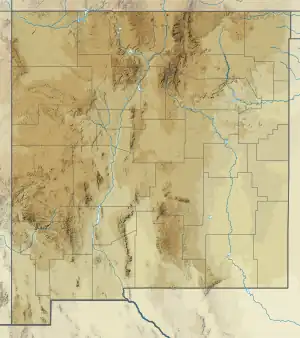| Sloan Canyon Formation | |
|---|---|
| Stratigraphic range: | |
| Type | Formation |
| Unit of | Dockum Group |
| Underlies | Sheep Pen Sandstone |
| Overlies | Travesser Formation |
| Thickness | 38–46 meters (125–151 ft) |
| Lithology | |
| Primary | Mudstone |
| Other | Siltstone, marl |
| Location | |
| Coordinates | 36°56′17″N 103°09′35″W / 36.9381°N 103.1598°W |
| Region | New Mexico |
| Country | United States |
| Type section | |
| Named for | Sloan Canyon |
| Named by | B.H. Parker |
| Year defined | 1930 |
 Sloan Canyon Formation (the United States)  Sloan Canyon Formation (New Mexico) | |
The Sloan Canyon Formation is a late Triassic geologic formation exposed in northeastern New Mexico.[1] Fossil theropod tracks have been reported from the formation.[2]
Description
The Sloan Canyon Formation consists of variegated reddish-brown, purple, and green mudstones, with some beds of siltstone and marl. It rests on the Travesser Formation and is overlain by the Sheep Pen Sandstone. Total thickness is 38–46 meters (125–151 ft).[3]
The formation is usually assigned to the Dockum Group.[1][3] The proposal of Spencer G. Lucas and his collaborators to abandon the Dockum Group, possibly in favor of the Chinle Group, is highly controversial.[4]
Fossils
A phytosaur skull was found in the Sloan Canyon Formation in 1939, establishing that it was a Triassic formation.[5] The formation is part of one of the largest continuously mapped Triassic vertebrate tracksites, with the earliest studied exposures at Peacock Canyon. Ichnofossils (track fossils) include the archosaurs Brachychirotherium and Chirotherium, a possible therapsid, and the reptile Rhynchosauroides.[6]
History of investigation
The beds now assigned to this unit were previously mistaken for Morrison Formation.[3] The Sloan Canyon Formation was first named by B.H. Parker in 1930.[7]
See also
References
- 1 2 Baldwin, Brewster; Muehlberger, W.R. (1959). "Geologic studies of Union County, New Mexico" (PDF). New Mexico Bureau of Mines and Mineral Resources Bulletin. 63 (2). Retrieved 1 September 2020.
- ↑ Weishampel, David B.; Dodson, Peter; Osmólska, Halszka, eds. (6 November 2004). "Dinosaur distribution". The Dinosauria (2nd ed.). Berkeley: University of California Press. pp. 517–607. ISBN 0-520-24209-2.
- 1 2 3 Ziegler, Kate E.; Ramos, Frank C.; Zimmerer, Matthew J. (2019). "Geology of Northeastern New Mexico, union and Colfax Counties, New Mexico: A Geologic Summary" (PDF). New Mexico Geological Society Field Conference Series. 70 (4): 47–54. Retrieved 1 September 2020.
- ↑ Lehman, T.M. (1994). "The saga of the Dockum Group and the case of the Texas/New Mexico boundary fault" (PDF). New Mexico Bureau of Mines & Mineral Resources Bulletin. 150: 37–51. Retrieved 1 September 2020.
- ↑ Stovall, J. Willis; Savage, Donald E. (October 1939). "A Phytosaur in Union County, New Mexico with Notes on the Stratigraphy". The Journal of Geology. 47 (7): 759–766. Bibcode:1939JG.....47..759S. doi:10.1086/624832. S2CID 128592690.
- ↑ Conrad, Kelly; Lockley, Martin G.; Prince, Nancy K. (1987). "Triassic and Jurassic vertebrate-dominated trace fossil assemblages of the Cimarron Valley region--Implications for paleoecology and biostratigraphy" (PDF). New Mexico Geological Society Field Conference Series. 38: 127–138. Retrieved 1 September 2020.
- ↑ Parker, B.H. (September 1–6, 1930). "Note on occurrence of clastic plugs and dikes in the Cimarron Valley area of Union County, New Mexico". Kansas Geological Society Guidebook for the Annual Field Conference. 4: 131–136.